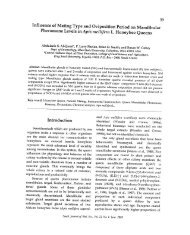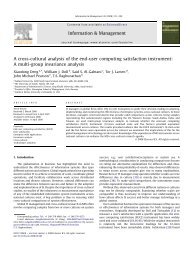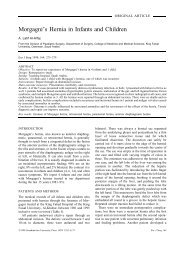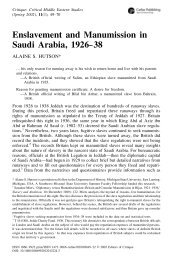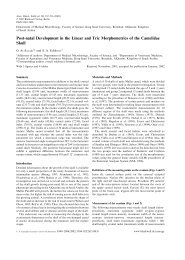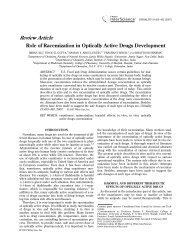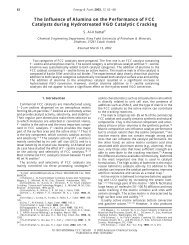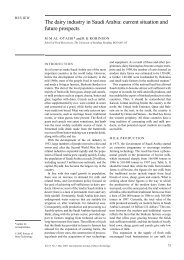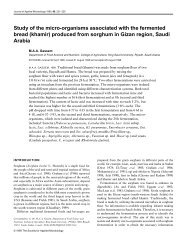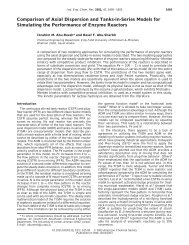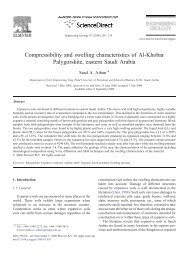Arabic translation across cultures
Arabic translation across cultures
Arabic translation across cultures
Create successful ePaper yourself
Turn your PDF publications into a flip-book with our unique Google optimized e-Paper software.
<strong>Arabic</strong> <strong>translation</strong> <strong>across</strong> <strong>cultures</strong>*<br />
M. A. Homeidi<br />
1. Introduction<br />
This article deals primarily with three concepts: <strong>translation</strong>, language and culture.<br />
Translation is defined, for our purpose, as follows:<br />
Translation is the expression in another language (or target language) of what<br />
has been expressed in another, source language, preserving semantic and stylistic<br />
equivalences (Bell 1991: 5)<br />
Language is defined as follows:<br />
A system for the expression of thoughts, feelings, etc., by the use of spoken sounds<br />
or conventional symbols.... to communicate with understanding because of common<br />
background, values, etc. (Collins English Dictionary 1983).<br />
Nida (1994: 150) expresses similar views:<br />
The nature of language explains in large part why translating is possible. The fact<br />
that all languages exhibit so many structural similarities guarantees the potential<br />
for effective interlingual communication... Although to a considerable extent languages<br />
can be regarded as “rule governed”, they are also “rule defying”, or perhaps<br />
more accurately stated, they are “rule stretching” in that analogies within languages<br />
can always be pushed into unused, nearby areas<br />
Language is not seen as “an isolated phenomenon suspended in a vacuum but<br />
as an integral part of culture” (Snell-Hornby 1988: 39).This brings us to the third<br />
of our concepts which is culture.<br />
The concept of culture was defined by the American ethnologist Ward H.<br />
Goodenough as follows:<br />
Babel 50:1 (2004), 13–27. issn: 0521–9744 / e-issn: 1569–9668<br />
© Fédération des Traducteurs (fit) Revue Babel
14 M. A. Homeidi<br />
As I see it, a society’s culture consists of whatever it is one has to know or believe in<br />
order to operate in a manner acceptable to its members, and do so in any role that<br />
they accept for any one of themselves. Culture, being what people have to learn as<br />
distinct from their biological heritage, must consist of the end product of learning:<br />
knowledge, in a most general, if relative, sense of the term. By this definition,<br />
we should note that culture is not a material phenomenon; it does not consist of<br />
things, people, behavior, or emotions. It is rather an organizing of these things. It<br />
is the forms of things that people have in mind, their models for perceiving, relating,<br />
and otherwise interpreting them. As such, the things people say and do, their<br />
social arrangement and events, are products or by-products of their culture as they<br />
apply it to the task of perceiving and dealing with their circumstances. To one who<br />
knows their culture, these things and events are also signs signifying the cultural<br />
forms or models of which they are material representations. (1964: 39–40)<br />
whereas Nida (1994: 157) defines culture as: “the total beliefs and practices of<br />
a society”. Words only have meaning in terms of the culture in which they are<br />
used, and although languages do not determine culture, they certainly tend to<br />
reflect a society’s beliefs and practice”.<br />
These three concepts interlock firmly in the <strong>translation</strong> of idioms and culturally<br />
bound pieces of language.<br />
2. Some notes on the <strong>translation</strong> of idioms<br />
Idioms are defined as follows:<br />
They are frozen patterns of language which allow little variation in form and, in the<br />
case of idioms, often carry meanings which cannot be deduced from their individual<br />
components. (Baker 1992: 63)<br />
Some easy examples might include the following: bury the hatchet, which can<br />
be translated into <strong>Arabic</strong> as: ﺎﻬﻳﺎﺠﻣ ﻰﻟ ﺎﻴﻤﻟ ﺎﻋ, or the long and short of it, which<br />
can be translated into <strong>Arabic</strong> as: ﺎﻬﻴﻓ ﺎﻣ ﺔﺼﻘﻟ ﻞﻛ.<br />
However, before we continue discussing some other idioms, let us see what<br />
are the main difficulties that may face the translator when translating idioms.<br />
The main difficulties were summarized in Baker (1992: 65) as follows:<br />
The main problems that idiomatic and fixed expressions pose in translating relate<br />
to two main areas: the ability to recognize and interpret an idiom correctly; and the<br />
difficulties involved in rendering the various aspects of meaning that an idiom or a<br />
fixed expression conveys into the target language. These difficulties are much more<br />
pronounced in the case of idioms than they are in the case of fixed expression.
<strong>Arabic</strong> <strong>translation</strong> <strong>across</strong> <strong>cultures</strong> 15<br />
Idioms can be classified into many types (see Baker 1992: 65). However, we will<br />
restrict our analysis to some as representative instances:<br />
2.1 Those that violate truth conditions (easily recognizable), such as:<br />
a. It is raining cats and dogs. The meaning of which can be translated into<br />
<strong>Arabic</strong> as: ﺮﻘﻟ ﻮﻓﺄﻛ ﺮﻄﻤﺗ ﺎﻬﻧ , (<strong>translation</strong> by an idiom, but different form).<br />
Notice that the phrase cats and dogs is replaced by jars of water<br />
b. Throw caution to the winds, which can be translated as:<br />
ﻲﺷ ﻷ ﺮﺘﻜﻳ ﺪﻌﻳ ﻢﻟ (<strong>translation</strong> by paraphrase)<br />
c. Jump down someone’s throat which can be translated as:<br />
(ﺔﻴﻣﺎﻌﻟ ﺔﺠﻬﻠﻟ ﻲﻓ ﻪﻠﺴﻏ) ﻒﻨﻌﺑ ﺦﺑﻮﻳ (<strong>translation</strong> by paraphrase)<br />
d. Storm in a tea cup which can be translated as:<br />
ﺎﺠﻨﻓ ﻲﻓ ﺔﻌﺑ (<strong>translation</strong> by another idiom of similar form)<br />
In fact there is no rule for translating the meanings expressed by this group of<br />
idioms except knowing the cultural equivalent of each in the target language<br />
regardless of the linguistic forms they take.<br />
This group might include expressions which seem ill-formed because they<br />
do not follow the grammatical rules of the language as the following (Baker<br />
1992: 65):<br />
e. Trip the light fantastic which might be translated into <strong>Arabic</strong> as:<br />
(ﺲﻨﺠﻟ ﺔﺳﺎﻤﻣ ﻮﻬﻠﻟ ﻲﻓ ﺔﻠﻴﻟ ﻲﻀﻤﻳ) ﺮﻤﺣ ﺔﻠﻴﻟ ﻲﻀﻤﻳ<br />
f. Blow someone to kingdom come which be translated into <strong>Arabic</strong> as:<br />
(ﻼﻣﺎﻛ ﺮﻴﻣﺪﺗ ﺎﻧﺎﺴﻧ ﺮﻣﺪﻳ) ﻷ ﻪﺟ ﻰﻠﻋ ﻦﻣ ﺢﺴﻤﻳ<br />
g. The world and his friend which might be translated into <strong>Arabic</strong> as:<br />
(ﻦﻳﺮﺿﺎﺤﻟ ﻊﻴﻤﺟ) ﺎﺴﻧ ﻞﻛ<br />
A third sub-group might include expressions which start with like (simile structure)<br />
as the following:<br />
h. Like a bat out of hell which might be translated into <strong>Arabic</strong> as:<br />
(ﺔﻴﻣﺎﻌﻟ ﺔﺠﻬﻠﻟ ﻲﻓ ﺎﻨﻟ ﺦﻴﺳ ﻞﺜﻣ) ﺔﻘﺋﺎﻓ ﺔﻋﺮﺴﺑ ﺎﺤﺴﻧﻻ/ﺎﻐﻤﻟ<br />
i. Like water off a duck’s back which might be translated as:<br />
(ﻂﺒﻟ ﻞﻳ ﻰﻠﻋ ﺎﻤﻟ ﺮﺛﺄﻛ) ﺮﺛ <br />
These tend to be translated in a semi-literal form.<br />
Some idioms may have either a literal <strong>translation</strong> which is acceptable out
16 M. A. Homeidi<br />
of a definite context, or an idiomatic <strong>translation</strong> when the context is known to<br />
the translator. Baker (1992: 66) mentions a very nice example relating to this<br />
point:<br />
I’d just done my stint as rubber duck, see, and pulled off the grandma lane into the<br />
pit stop to drain the radiator.<br />
If I am supposed to translate this into <strong>Arabic</strong> without any support from the context<br />
or otherwise, my <strong>translation</strong> will get stuck when translating the following<br />
expressions: rubber duck, grandma, simply because the literal meaning does<br />
not help. Assuming that I could reach the required meaning from a good reference<br />
about idioms or from a native speaker who is familiar with the language<br />
of truck drivers, still my <strong>translation</strong> would still render only the literal meaning<br />
of drain the radiator, and my <strong>translation</strong> might be as follows:<br />
ﺎﻨﺣﺎﺸﻟ ﺎﺑﺮﻌﻟ ﺮﻴﺴﻟ ﺺﺼﺨﻤﻟ ﺎﺴﻤﻟ ﻦﻣ ﺖﺟﺮﺧ ،ﻞﺗﺮﻠﻟ ﺪﺋﺎﻗ ﻲﺘﻤﻬﻣ ﺖﻴﻬﻧ ﺪﻘﻟ<br />
.ﻊ ﺸﻤﻟ ﺮﻓ ﻲﻜﻟ ﺔﺣﺮﺘﺳﻻ ﻲﻓ ﻒﻗﻷ ،ﺔﺌﻴﻄﺒﻟ\ ﺔﻠﻴﻘﺜﻟ<br />
Of course this is a literal <strong>translation</strong> of the original text; but the real idiomatic<br />
meaning of the original is completely different. Now assuming I know the idiomatic<br />
meaning of the phrase to drain the radiator in the context of truck driving,<br />
then my <strong>translation</strong> can be revised as follows:<br />
ﺎﻨﺣﺎﺸﻟ ﺎﺑﺮﻌﻟ ﺮﻴﺴﻟ ﺺﺼﺨﻤﻟ ﺎﺴﻤﻟ ﻦﻣ ﺖﺟﺮﺧ ،ﻞﺗﺮﻠﻟ ﺪﺋﺎﻗ ﻲﺘﻤﻬﻣ ﺖﻴﻬﻧ ﺪﻘﻟ<br />
.«ﺎﻤ ﺤﻠﻟ ﺐﻫ» ،ﻮﺒﺗ ﻲﻜﻟ ﺔﺣﺮﺘﺳﻻ ﻲﻓ ﻒﻗﻷ ،ﺔﺌﻴﻄﺒﻟ\ ﺔﻠﻴﻘﺜﻟ<br />
The point is that without knowing exactly the idiomatic use of the phrase to<br />
drain the radiator, in the context of truck driving, I would have never been able<br />
to render the meaning properly in <strong>Arabic</strong>. This is an example of the importance<br />
of context and cultural background in <strong>translation</strong>.<br />
3. On the <strong>translation</strong> of some culturally bound expressions and<br />
phrases<br />
3.1 On the <strong>translation</strong> of some English phrases into <strong>Arabic</strong><br />
Some English examples are the <strong>translation</strong>s of the following phrases:<br />
one parent child, palimony, car boot sale, mentors, big brothers and sisters organization
<strong>Arabic</strong> <strong>translation</strong> <strong>across</strong> <strong>cultures</strong> 17<br />
The literal <strong>translation</strong> of these phrases out of context may be as follows:<br />
ﻮﺧﻷ ﺔﻤﻈﻨﻣ ،ﻮﻓﺮﺸﻤﻟ ،ﺎﻴﺴﻟ ﺪﻨﺻ ﻊﻴﺑ ،ﺎﻗﺪﺻﻷ ﺔﻘﻔﻧ ،ﻂﻘﻓ ﻦﻳﺪﻟﻮﻟ ﺪﺣ ﻦﻣ ﻞﻔﻃ<br />
.ﺎﺒﻜﻟ ﻮﺧﻷ<br />
I don’t think that such <strong>translation</strong> means a lot to the target reader. In fact, it does<br />
not reveal the correct or semi-correct meaning of the English. Even if we put<br />
them in complete sentences still the correct meaning is opaque:<br />
(1) The one parent child association released its latest booklet which includes<br />
all the services it offers to its members.<br />
(2) The Lee Marvin palimony case... shows that... married or unmarried...<br />
people who live together can not avoid a shared responsibility. (See Neubert<br />
et al. 1992: 67).<br />
(3) According to the police, car boot sales are notorious places where stolen<br />
goods are sold (The Express, Saturday, February 20, 1999).<br />
(4) In the US, an organization called big brothers and sisters provides mentors<br />
for under-privileged and high-risk children (ibid.).<br />
If we translate the sentences (1–4) without any help from the context, which is<br />
not clear at all from the sentences themselves, we may get the following:<br />
ﺬﻟ ﺎﻬﺗﺎﺒﻴﺘﻛ ﺮﺧ (one parent child) «ﻂﻘﻓ ﻦﻳﺪﻟﻮﻟ ﺪﺣ ﻦﻣ ﻞﻔﻄﻟ ﺔﻴﻌﻤﺟ» ﺪﺻ (1a)<br />
.ﺎﻬﺋﺎﻀﻋﻷ ﺎﻬﻣﺪﻘﺗ ﻲﺘﻟ ﺎﻣﺪﺨﻟ ﻢﻀﻳ<br />
ﻦﻳﺬﻟ ﺎﻨﻟ (palimony) ﺎﻗﺪﺻﻷ ﺔﻘﻔﻧ ﻊﻓ ﻰﻠﻋ ﻪﺗﺮﺒﺟ ﻲﺘﻟ ﻦﻓﺎﻣ ﻲﻟ ﺔﻴﻀﻗ ﺖﺤﺿ (2a)<br />
ﻮﻧﺎﻛ ﻮﺳ ﺔﻛﺮﺘﺸﻤﻟ/ﺔﻟﺎﺒﺘﻤﻟ ﺔﻴﻟﺆﺴﻤﻟ ﻦﻣ ﻞﺼﻨﺘﻟ ﻢﻬﻨﻜﻤﻳ ﻻ ﺎﻀﻌﺑ ﻢﻬﻀﻌﺑ ﻊﻣ ﻮﺸﻴﻌﻳ<br />
.ﻦﻴﺟﺰﺘﻣ ﺮﻴﻏ ﻦﻴﺟﺰﺘﻣ<br />
ﻊﻴﺒﻟ ﻮﻬﺸﻣ ﻦﻛﺎﻣ (car boot sale) ﺎﻴﺴﻟ ﺪﻨﺻ ﺎﻌﻴﺒﻣ ﻞﻜﺸﺗ ،ﺔﻃﺮﺸﻟ ﺎﺼﻤﻟ ﺎﻘﻓ (3a)<br />
.ﺔﻗﺮﺴﻤﻟ ﻊﺋﺎﻀﺒﻟ<br />
big brothers and) «ﺎﺒﻜﻟ ﻮﺧﻷ ﻮﺧﻷ» ﻰﻋﺪﺗ ﺪﺤﺘﻤﻟ ﺎﻳﻻﻮﻟ ﻲﻓ ﺔﻤﻈﻨﻣ ﺎﻨﻫ (4a)<br />
ﻦﻴﺿﺮﻌﻤﻟ ﺮﻘﻔﻟ ﺎﻔﻃﻸﻟ (Mentors) «ﻦﻳﺪﺷﺮﻣ/ﻦﻴﺑﺮﻣ/ﻦﻴﻓﺮﺸﻣ» ﻦﻴﻣﺄﺘﺑ ﻮﻘﺗ (sisters<br />
.ﺮﻴﺒﻛ ﺔﺟﺪﺑ ﺮﺤﻧﻼﻟ<br />
Although the phrase one parent child in (1) is translated through paraphrasing<br />
(for lack of a formal equivalence) into a complete clause i.e. (1a) to clarify its<br />
meaning in English, nonetheless, the meaning of the <strong>Arabic</strong> <strong>translation</strong> is very<br />
far from being transparent. An Arab or a Muslim reader can not understand<br />
the notion of a child with one parent only. The nearest notion in the Islamic culture<br />
to the phrase one parent child is the child who has lost one or both parents,<br />
in which latter case it is called an orphan in English. Even in this latter case, i.e.<br />
losing one’s parents in war or earthquake etc., the parents of the child are still
18 M. A. Homeidi<br />
known through the Civil Service Records. In the case of a child who is found<br />
by itself without it being possible to know its parents by any means, it is called<br />
ﻂﻴﻘﻟ laqiit, i.e. foundling not one parent child.<br />
This phrase reflects the existence of a concept which, in turn, reflects an<br />
event/action that is not found in the <strong>Arabic</strong> or Islamic culture. Any rendering<br />
of the phrase one parent child without adding a commentary or a footnote will<br />
not yield a <strong>translation</strong> that is understandable to the Arab reader. (1a) could be<br />
adopted as an acceptable <strong>translation</strong>, but only if it is coupled with the following<br />
commentary:<br />
(5) It is possible for a woman in the western world to have a baby from with any<br />
man she likes, and she is not legally obliged to declare the father’s name or<br />
nationality etc. or she may not be certain about them. In this case the family<br />
which consists of only the mother and the child(ren) is called “one parent<br />
family” and the child(ren) is/are called “one parent child(ren)”.<br />
Now the <strong>translation</strong> in (1a) could be modified to include the additional meanings<br />
expressed in the commentary, in which case it might be as follows:<br />
(ﺎﻴﺣﻷ ﺐﻠﻏ ﻲﻓ ﻷ) ﻦﻳﺪﻟﻮﻟ ﺪﺣ ﻒﻨﻜﺑ ﻮﺸﻴﻌﻳ ﻦﻳﺬﻟ ﺎﻔﻃﻷ ﺔﻴﻌﻤﺟ ﺪﺻ (6)<br />
ﺎﻬﻣﺪﻘﺗ ﻲﺘﻟ ﺎﻣﺪﺨﻟ ﻢﻀﻳ ﺬﻟ ﺎﻬﺗﺎﺒﻴﺘﻛ ﺮﺧ ،ﻢﻫﺎﺑ ﻮﻓﺮﻌﻳ ﺮﻀﻟ ﻦﻣ ﺲﻴﻟ ﻦﻳﺬﻟ<br />
.ﺎﻬﺋﺎﻀﻋﻷ<br />
Without such commentary the <strong>translation</strong> is not understandable at all. Although<br />
(6) is more accessible to the target reader, nevertheless it is still opaque<br />
without the commentary in (5).<br />
Let us move to (2a) which represents the <strong>translation</strong> of (2). The problem lies<br />
in the word palimony (pal informally means a close friend + alimony, an allowance<br />
paid under a court order by one spouse to another when they are separated,<br />
either before or after divorce, Collins English Dictionary 1983) Arabs and<br />
Muslims in general cannot understand how a person could be obliged to pay<br />
a regular sum of money for someone he or she is not legally married to. More<br />
than that, according to the Arab’s culture and religion and in fact to all Muslims<br />
alimony, rather than palimony, is to be paid by a husband to his former wife if<br />
they are legally divorced, but the opposite can never be, i.e. a divorced woman<br />
can never be obliged, neither by court nor by culture or tradition, to pay alimony<br />
to her divorced husband. We have a twofold cultural gap: first, in the Islamic<br />
culture and religion we can not have a couple living together as husband<br />
and wife without being married legally; and second, in the case of divorce, only<br />
the man can be obliged by court to pay alimony. How to overcome this cultur-
<strong>Arabic</strong> <strong>translation</strong> <strong>across</strong> <strong>cultures</strong> 19<br />
al gap? I believe that the translator has to translate the original and then supply<br />
the necessary missing information either by a footnote or between parentheses.<br />
(2a) could be accepted as an adequate <strong>translation</strong> with the following commentary:<br />
(7) It is common in Western civilization for a man and a woman to live under<br />
one roof and to have a sexual relationship without being married legally.<br />
Without the additional commentary (2a) would not achieve its purpose.<br />
Turning now to (3a), we find that the problem lies in the phrase car boot<br />
sale. The nearest equivalent in <strong>Arabic</strong> would be an auction sale, which is, of<br />
course, not what car boot sale is. This problem too is a cultural mismatch. (3a)<br />
could be accepted but only with the following commentary:<br />
(8) In Britain, it is usual for a person to collect some goods (second hand or new)<br />
in his car boot, and sell them in some assigned places on weekends, special<br />
occasions, festivals etc. and this event is called car boot sale.<br />
Moving to (4a), we have two unfamiliar phrases: big brothers and sisters and<br />
mentors. Each of them needs a commentary from the translator because the<br />
concepts that lie behind them are not found in the <strong>Arabic</strong> culture yet. The nearest<br />
equivalents to mentor in <strong>Arabic</strong> would be mushref which means academic<br />
supervisor, or murabii which means a person who teaches small children good<br />
behavior, or mu’adeb, which is a synonym to murabii. However, these words are<br />
not equivalent to the English original, so (4a) could be adopted as a <strong>translation</strong><br />
but only with the following commentary:<br />
(9) In the USA, there is a special organization of adults and experienced volunteers<br />
who spend about five hours weekly with underprivileged or high-risk<br />
children to help them overcome the difficulties they may face in their daily<br />
life so that they may not be victims of drug traffickers etc. A member in this<br />
organization is called a mentor and the organization itself is called Big Sisters<br />
and Brothers.<br />
The point I would like to stress is that in these cases the event/case is not found<br />
in the Arab/Muslim target culture, therefore the concept expressing it does not<br />
exist and consequently, the language has not devised linguistic means to express<br />
it.<br />
These examples have shown that Bassnet (1998: 79–81 passim) is absolutely<br />
right when she expresses similar ideas:
20 M. A. Homeidi<br />
But all sorts of things happen during <strong>translation</strong>. It may be that some words and<br />
phrases are untranslatable because they do not exist outside the source language.<br />
Or the form may be untranslatable... And it is important to recognize that the task<br />
of the translator is not to ignore cultural difference and to pretend that there is such<br />
a thing as universal truth and value free cultural exchange, but rather to be aware of<br />
those differences. Through awareness, translators may find a way of helping readers<br />
<strong>across</strong> frontiers, some of which are heavily armed and dangerous to approach.<br />
Nevertheless, the translator always, essentially, works with language...Try as I may,<br />
I cannot take language out of culture or culture out of language.<br />
3.2 On the <strong>translation</strong> of some <strong>Arabic</strong> culturally-bound phrases into English<br />
Let us take the following sentences:<br />
.ﺮﺼﻌﻟ ﻼﺻ ﻲﻠﺼﻳ ﻲﻛ ﻢﻤﻴﺘﻟ ﻦﻣ ﻪﻟ ﺪﺑﻻ ﺎﻛ ﻪﻳﺪﻟ ﺎﻤﻟ ﻞﻛ ﻚﻠﻬﺘﺳ ﺪﻌﺑ (10)<br />
.ﻲﺿﺎﻤﻟ ﺎﻀﻣ ﻲﻓ ﺎﻳ ﺮﺸﻋ ﺪﻤﻟ ﺪﺠﺴﻤﻟ ﻲﻓ ﺎﺟ ﻒﻜﺘﻋ ﺪﻘﻟ (11)<br />
.ﺎﻛﺰﻟ ﻊﻓ ﻦﻣ ﺪﺑﻻ ﺎﻴﻘﻴﻘﺣ ﺎﻨﻣﺆﻣ ﻮﻜﺗ ﻲﻛ (12)<br />
Any kind of <strong>translation</strong> of these sentences into English will reveal the non-existence<br />
of a concept in English, which is found in <strong>Arabic</strong>. A provisional <strong>translation</strong><br />
of sentences (10)–(12) might be as follows<br />
(10a) After he had used all the water he had, he was obliged to perform ’al-tayammum<br />
(sand ablution) to perform the ’al’aser (afternoon) prayer.<br />
(11a) My neighbour ’i c takafa (secluded) himself in the mosque for ten days last<br />
Ramadan.<br />
(12a) To be a true believer, you have to pay ’alzakaata (alms).<br />
Let us check whether the <strong>translation</strong> of the words in italics have inspired the<br />
same effect or meaning in the English reader as the originals for an Arab or a<br />
Muslim. For this purpose, I checked two monolingual English dictionaries viz:<br />
Collins English Dictionary, 1983, Longman Dictionary of Contemporary English,<br />
1995,<br />
and two bilingual dictionaries (<strong>Arabic</strong>–English) viz:<br />
The Hans Wehr Dictionary of Modern Written <strong>Arabic</strong>, Spoken Language Services,<br />
Ithaca, New York, 1983<br />
’al-Mawrid, An <strong>Arabic</strong>–English Dictionary, Dar El-Ilm Lil-Malayeen, Beirut,<br />
1988<br />
and a specialized dictionary in religious terms viz. A Dictionary of Religious
<strong>Arabic</strong> <strong>translation</strong> <strong>across</strong> <strong>cultures</strong> 21<br />
Terms, English–<strong>Arabic</strong> and <strong>Arabic</strong>–English, Abdullah Abu-Eshy Al-Maliki et al.,<br />
Obeikan Bookshop, Riyadh, 1995<br />
Assuming that the reader of these <strong>translation</strong>s has the competence expressed<br />
in these dictionaries, but has no access to a native speaker of <strong>Arabic</strong> nor, to a<br />
Muslim that has a fair knowledge of the religious content of these words, let us<br />
see what kind of meaning he is going to derive.<br />
For ablution in (10a) he will read in Collins English dictionary the following:<br />
Ablution: n. 1. the ritual washing of a priest’s hands or of sacred vessels. 2. (often pl.)<br />
the act of washing (esp. in the phrase perform one’s ablution).<br />
The meanings given in the above quotation from Collins do not render exactly<br />
what ablution means in <strong>Arabic</strong> or, in the Islamic religion as all Muslims know,<br />
since ablution is performed by everybody, not only priests, or religious people,<br />
before performing certain religious duties, especially the five daily prayers.<br />
On the other hand, the English reader will find in Longman the following:<br />
Ablutions: n. the things that you do to make yourself clean, such as washing yourself,<br />
cleaning your teeth etc.<br />
In fact, Longman’s interpretation of ablution is very far from the real meaning<br />
of the word in Islam. Compare the following:<br />
(13) Ablution: a ritual purification/cleaning of parts of the body [namely: the<br />
two hands from the elbow downward, the face, the two feet from the ankle,<br />
washing the mouth by gargling with water, cleaning the nose by rinsing it<br />
with water, and cleaning the hair and the outer part of the ear (pinna) by<br />
wiping them with wet hands] stipulated as a precondition for certain acts<br />
of worship like prayer, recitation of the Holy Qur ’ an, circumambulation<br />
around the Holy Ka c ba etc.<br />
(A Dictionary of Religious Terms. The specification in brackets are mine).<br />
In Islam, if a person does not have water for any reason (as being in a place very<br />
far from water, or isolated for some time) he is allowed to use clean sand instead<br />
of water for his ablution. “This way of purification is resorted to only in<br />
the absence of water and as temporary alternative to ablution. Such ritual purification<br />
is performed by striking the hands against clean sand and then passing<br />
them over the face” (ibid: 189). This is called sand ablution. This is the action the<br />
word ’altayammum indicates in (10a).
22 M. A. Homeidi<br />
It is doubtful whether the English reader can infer the Islamic meanings<br />
of the word ablution depending only on the monolingual dictionaries he has.<br />
Indeed it is not clear whether any <strong>translation</strong> of ’altayammum in English will<br />
render the appropriate meaning; therefore I suggest that the <strong>translation</strong> in (10a)<br />
should include the transliteration of the <strong>Arabic</strong> and the English <strong>translation</strong> be<br />
followed by the commentary given in (13). Alternatively, the reader may be advised<br />
to consult a specialized dictionary.<br />
Moving now to (11a), we find the word ’i c takafa which is translated as secluded.<br />
Resorting to the above-mentioned monolingual dictionaries we find in<br />
Collins the following:<br />
Seclude vb (tr.): to remove from contact with others. 2. To shut off or screen from<br />
view.<br />
while in Longman we find:<br />
Seclude v [tr.]: to keep yourself or someone else away from other people.<br />
If we know that the meaning expressed by the verb ’i c takafa in (11a) is something<br />
like:<br />
(14) Seclusion in a mosque during the last ten days of Ramadan for the purpose<br />
of worshipping Allah, only. The one in such a state should not have sexual relations<br />
with his wife, and one is not allowed to leave the mosque, except for<br />
a very short period of time and only for special or urgent purposes, i.e., answering<br />
the call of nature, for taking meals, to join a funeral procession, etc.<br />
(A Concise Dictionary of Islamic Terms 27)<br />
then I think the English reader will immediately recognize the differences in<br />
meanings between the <strong>Arabic</strong> concept expressed in the verb ’i c takfa and the<br />
English one seclude in this context. It should be added that this seclusion of<br />
oneself is completely voluntary in Islam, whereas the meanings expressed by<br />
the verb seclude might include compulsory seclusion according to Longman’s.<br />
Also if the reader knows that Ramadan in (11a) is the month of fasting for Muslims,<br />
this will help him narrow the meanings of verb ’i c takfa to those releated<br />
to worship. Therefore I would advise the translator to couple his <strong>translation</strong> in<br />
(11a) with the additional explanations in (14). He may also leave the transliteration<br />
of the <strong>Arabic</strong> verb in the text so that the interested reader may consult an<br />
<strong>Arabic</strong>–<strong>Arabic</strong> dictionary or a specialized one in the field.<br />
Let us move now to (12a) which includes the word ’alzakata, which is translated<br />
into English as alms. Returning to our English–English dictionaries, we<br />
find in Collins the following:
<strong>Arabic</strong> <strong>translation</strong> <strong>across</strong> <strong>cultures</strong> 23<br />
Alms pl. n. charitable donations of money or goods to the poor or needy.<br />
whereas in Longman we find:<br />
Alms n [plural] old-fashioned money, food, clothes etc that are given to the poor<br />
people.<br />
The reader of (12a) might feel puzzled or might think that there is a contradiction<br />
since true believing is apparently conditioned by the donation of some<br />
money, old clothes etc. to the poor or needy. And above all charities can never<br />
be compulsory at any rate. This is the meaning derived from (12a) and the English–English<br />
dictionaries mentioned above.<br />
Now if the target reader is informed that the meanings of the word ’alzakaat in<br />
(12a) are something like the following:<br />
(15) ’alzakatu/ n One of the five Pillars of Islam designating a compulsory form<br />
of poor owing amounting to 2.5% of the surplus wealth over and above a<br />
stipulated minimum rate (called nisaab) that has remained in the possession<br />
of a Muslim for a year. The following categories of people are entitled<br />
to this poor owing: the poor, the needy, those who are charged with collecting<br />
it, those who are newly converted to Islam and those whose faith is<br />
still weak and need encouragement to consolidate their faith. In addition,<br />
’alzakaat may also be paid for setting captives free, for assisting those who<br />
are in debt, for promoting the cause of Allah, and/or for wayfarers. ’alzakaat<br />
is paid once a year.<br />
(Adapted from A Dictionary of Religious Terms)<br />
I believe that our target reader will derive meanings that may be either completely<br />
or relatively different from the ones he derived before. This analysis in<br />
(15) shows that ’alzakaat cannot be taken to mean alms in absolute terms; they<br />
may overlap in meanings but they are not interchangeable. The information in<br />
(15) should be known to the translator and should be included in the translated<br />
text in the form of a commentary or footnote.<br />
Is this <strong>translation</strong> or something else? Should the translator add all this information?<br />
Is he allowed to? I believe the answer may be yes if the following<br />
statements are accepted:<br />
Vermeer has for many years vehemently opposed the view that <strong>translation</strong> is simply a<br />
matter of language: for him <strong>translation</strong> is primarily a cross-cultural transfer (see Vermeer<br />
1986) , and in his view the translator should be bicultural, if not pluricultural, ...<br />
Secondly, Vermeer views <strong>translation</strong> as action, as “Sondersorte von Handeln” (1986),<br />
in other words, it is a cross-cultural event (Snell-Hornby 1988: 46).
24 M. A. Homeidi<br />
The key thing is therefore that when confronted with a problem case, we should decide<br />
what the appropriate strategy should be and that the decision arrived at should<br />
be governed by more far-reaching considerations of text-function within situation<br />
within culture (Kussmaul 1995: 72).<br />
The translator may have to intervene by inserting footnotes, providing translators<br />
notes, or creating explanatory paraphrases. The translator is trying to bring the L2<br />
reader to an informational threshold by providing extra information. Informativity<br />
is not just a function of transferring information already in a text (Neubert &<br />
Shreve 1991: 91).<br />
If we base <strong>translation</strong> theory on <strong>translation</strong> practice, then we are not faced with<br />
choosing linguistic/semantic over pragmatic/communicative approaches or emphasizing<br />
source-culture over target-culture values. Rather, we recognize that there is a<br />
<strong>translation</strong> reality which is extremely diverse and which calls for different <strong>translation</strong><br />
responses. Our approach to <strong>translation</strong> insists that all of these approaches are<br />
valid if they have a basis in the textuality of <strong>translation</strong> and are empirical in method.<br />
(ibid: 35)<br />
We have resorted to this strategy of coupling the <strong>translation</strong> of the original text<br />
with a commentary because the word in the original text embodies a concept<br />
that reflects an action/event which is not found in the target language and culture.<br />
The translator has to compensate for this mismatch between the two languages<br />
and <strong>cultures</strong> if his <strong>translation</strong> is to interpret the source text correctly<br />
both linguistically and culturally.<br />
4. Conclusion<br />
I would like to finish this article with some other comments about the possible<br />
ways of translating idioms and culturally bound expressions. Baker (1992: 71–<br />
78) mentions four strategies for translating idioms namely: (a) using an idiom<br />
of similar meaning and form, (b) using an idiom of similar meaning but dissimilar<br />
form, (c) <strong>translation</strong> by paraphrase, and (d) <strong>translation</strong> by omission. She<br />
(1992: 78) touches very briefly on another strategy when she says:<br />
One strategy which can not be adequately illustrated, simply because it would take up<br />
a considerable amount of space, is the strategy of compensation.<br />
We think this is the strategy which may be the proper one in translating some<br />
culturally bound expressions. In this strategy the translator is called on to intervene<br />
and supply the information required to make the processing of the idiom<br />
or other similar phrases possible in the target language. If he does not in-
<strong>Arabic</strong> <strong>translation</strong> <strong>across</strong> <strong>cultures</strong> 25<br />
tervene, the purpose of <strong>translation</strong> as an act of cross-cultural communication is<br />
not respected, and we can be sure that the reader in the target language will not<br />
get the message expressed in the source text. The following quotation makes<br />
the point:<br />
A good translator will almost invariably supply extra information in the L2 text.<br />
The L2 community does not share the mutual knowledge necessary to make the<br />
appropriate references to social, cultural, and geographical phenomena. (Neubert<br />
et al., 1992: 79).<br />
Tannen, expresses similar views, concerning the pragmatics of teaching, understanding,<br />
and learning the cultural aspects of foreign languages, which can be<br />
extended to the <strong>translation</strong> of culturally bound expressions. She says:<br />
Note<br />
Ways of communicating meaning in talk are learned in the speech community, that<br />
is by talking to people with whom one identifies socially. As social networks are always<br />
local, not global, people in different communities have different ways of using<br />
linguistic means to communicative ends, and their ways of talking, like other cultural<br />
patterns, define them as a community. This illustrates Hall’s (1959) assertion that culture<br />
is communication. To the extent that no two people have exactly the same communicative<br />
background, to that extent, all communication is cross-cultural, and understanding<br />
cross-cultural communication is a means to understanding language at<br />
the same time that it is a means to understanding and, one hopes, improving problems<br />
and tasks facing the world and the people in it, including the task of teaching<br />
and learning new languages [and <strong>translation</strong> <strong>across</strong> <strong>cultures</strong>] (Tannen 1983: 194. The<br />
emphasis and words in square brackets are mine.)<br />
* I would like to express my deepest thanks to Prof. Brian Harris for his editorial comments<br />
which gave this article its final shape.<br />
References<br />
Baker, M. 1992. In Other Words, a course book on <strong>translation</strong>, Routledge, xii+303pp.<br />
Bassnett, S. 1998. Translation Across culture, in Language at Work, British Studies in Applied<br />
Linguistics, 13: 72–85, 1998.<br />
Goodenough, W.H. (ed.), 1964. Explorations in Cultural Anthropology, McGraw-Hill.<br />
Kussmaul, P., 1995. Training The Translator, Amsterdam,John Benjamins Publishing Company,<br />
x+177 pp.<br />
Neubert, A. & Shreve G.M. 1992. Translation As Text, Kent University State Press, xiv+ 169<br />
pp.
26 M. A. Homeidi<br />
Nida, E. 1994. Translation: possible and impossible, Turjuman 3 (2), 146–163.<br />
Snell-Hornby, M. 1988. Translation Studies, An Integrated Approach, Amsterdam, John Benjamins<br />
Publishing Company, vii+172 pp.<br />
Tannen, D. The Pragmatics of Cross-Cultural Communication, Applied Linguistics, 3, 1983,<br />
189–195.<br />
Dictionaries<br />
Collins English Dictionary, 1983. xxxvi + 1692 pp.<br />
The Hans Wher Dictionary of Modern Written <strong>Arabic</strong>, 1983. Spoken Language Services, Inc,<br />
xvii +1110 pp.<br />
Qaazi, M. A., 1979. A Concise Dictionary of Islamic Terms, Kazi Publications, Chicago vi +<br />
80 pp.<br />
Longman Dictionary of Contemporary English, 1995. xxii + 1690 pp.<br />
Abdullah Abou-Eshy Al-Maliki et al., 1995. A Dictionary of Religious Terms. Obeikan Bookshop,<br />
Riyadh xix + 366 pp.<br />
Abstract<br />
This paper deals mainly with some of the difficulties the translator might encounter<br />
when translating some culturally bound pieces of information. These would include the<br />
<strong>translation</strong> of some idioms, and some culturally bound concepts.<br />
The paper starts with definitions of <strong>translation</strong>, language and culture followed by<br />
an extensive analysis of the examples provided. All the examples are drawn from <strong>Arabic</strong><br />
and English. The examples include the <strong>translation</strong> of some idioms which violate truth<br />
conditions, which are easily recognizable, and some others which may be translated either<br />
literally or idiomatically with obviously different results.<br />
Then the analysis moves to the <strong>translation</strong> of some culturally bound expressions<br />
from both <strong>Arabic</strong> and English. Here, we find examples that cannot be translated into the<br />
other language simply for lack of cultural equivalents. The skill and the intervention of<br />
the translator are most needed in this respect because above all <strong>translation</strong> is an act of<br />
communication.<br />
Résumé<br />
Cet article traite principalement de certaines difficultés que le traducteur peut rencontrer<br />
quand il traduit des textes d’information qui présentent un aspect culturel. Ces difficultés<br />
ont trait à certaines locutions idiomatiques et concepts culturels.<br />
L’article commence par définir la traduction, la langue et la culture, puis analyse<br />
en détail les exemples fournis. Tous les exemples sont tirés de l’arabe et de l’anglais. Ces<br />
exemples comprennent la traduction de certaines locutions idiomatiques qui trahissent
<strong>Arabic</strong> <strong>translation</strong> <strong>across</strong> <strong>cultures</strong> 27<br />
les conditions de vérité et sont facilement reconnaissables, et de quelques autres qui<br />
peuvent être traduites soit littéralement, soit de manière idiomatique, mais avec bien<br />
sûr des résultats différents.<br />
Puis l’analyse passe à la traduction de certaines expressions de nature culturelle, en<br />
arabe et en anglais. Nous y trouvons des exemples qu’il est impossible de traduire dans<br />
l’autre langue, tout simplement parce qu’il leur manque des équivalents culturels. L’habileté<br />
et l’intervention du traducteur sont des plus nécessaires dans ce cas, parce que la<br />
traduction est avant tout un acte de communication.<br />
About the author<br />
Moheiddin A. Homeidi, Ph.D. in theoretical linguistics (syntax), University of Essex (1987).<br />
He has translated many books into <strong>Arabic</strong> in many fields. The following are <strong>translation</strong>s in<br />
the fields of language and linguistics (1) The Speech Chain, by Peter Dennis and Eliot Pension<br />
(1992), (2) A Linguistic Theory of Translation, (1992) by J. C. Catford, (3) Speech Science<br />
Primer (1998) by Gloria Borden et al., (4) An Encyclopaedia of Language (2001) by N.E. Collinage,<br />
(5) Translation as Text (2002) by Neubert, A. et al. (6) Translation and Translating,<br />
(2001) by Roger Bell. He is mainly interested in the <strong>translation</strong> of language and linguistics<br />
books; in addition to the comparative syntactic analyses between <strong>Arabic</strong> and English in the<br />
Minimalist approach.<br />
Address: European Languages and Translation Dept. College of Languages and Translation,<br />
King Saud University, P.O.Box 87907 Riyadh 11652, Saudi Arabia. E-mail: moheiddin3@<br />
yahoo.com<br />
Chambre<br />
Belge des<br />
Interprètes et<br />
Philologes<br />
Belgische<br />
Kamer van<br />
Vertalers en<br />
Filologen<br />
LE LINGUISTE DE TAALKUNDIGE<br />
Revue trimestrielle Driemaandelijks tijdschrift<br />
Rédacteur en chef: M. FLAMME, Avenue Demolder 102,<br />
B-1342 Limelette<br />
Comité de rédaction: M.L. Bouchons, R. Haeseryn, W. Zöller<br />
Condition pour les non-membres<br />
Prix au numéro: Euro 5,00<br />
Abonnement annuel: Euro 25,00 / Euro 37,00 hors Belgique<br />
Paiement: par virement ou versement au CCP nº 000-0073269-34 ou<br />
compte bancaire 310-0463867-02 de la Chambre Belge des Traducteurs,<br />
Interprètes et Philologes, Bruxelles



